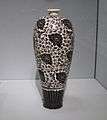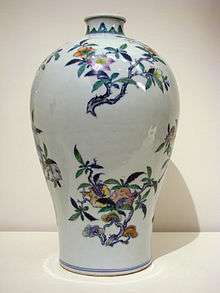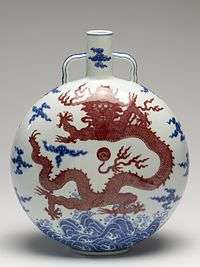Meiping
A meiping (Chinese: 梅瓶; pinyin: méipíng; lit.: 'plum vase') is a type of vase in Chinese ceramics.[1] It is traditionally used to display branches of plum blossoms.[1][2] The meiping was first made of stoneware during the Tang dynasty (618–907).[3] It was originally used as a wine vessel, but since the Song dynasty (960–1279) it also became popular as a plum vase and got its name "meiping".[4] It is tall, with a narrow base spreading gracefully into a wide body, followed by a sharply-rounded shoulder, a short and narrow neck, and a small opening.[2][4][5]
They may have lids, and many lids have no doubt been lost. The equivalent shape in Korean ceramics, where it was derived from Chinese examples, is called a Maebyeong. A distinct variant is the "truncated meiping", where there is only the top half of the usual shape, giving a squat vase with a wide bottom. This is largely restricted to Cizhou ware.[6]
 Cizhou ware, 13th century, Song dynasty
Cizhou ware, 13th century, Song dynasty_with_Lotus_Sprays_LACMA_AC1999.38.6.1-.2.jpg) Lidded vase with lotus sprays, Qingbai ware, Southern Song period
Lidded vase with lotus sprays, Qingbai ware, Southern Song period- Yaozhou ware, celadon, Song dynasty
_with_Horizontal_Ribs_LACMA_AC1994.191.1.jpg) Vase with horizontal ribs, Southern Song period
Vase with horizontal ribs, Southern Song period- Vase with copper-red underglaze, Ming dynasty
 18th-century vase
18th-century vase Porcelain, Jingdezhen ware, painted with cobalt blue under transparent glaze, 15th century
Porcelain, Jingdezhen ware, painted with cobalt blue under transparent glaze, 15th century
References
- Welch, Patricia Bjaaland (2008). Chinese art: a guide to motifs and visual imagery. North Clarendon: Tuttle Publishing. p. 17. ISBN 978-0-8048-3864-1.
- "Prunus Vase (meiping)". Saint Louis Art Museum. Retrieved 17 August 2011.
- "Fire Gilded Silver #Item3755". TK Asian Antiquities. Archived from the original on 31 March 2012. Retrieved 22 August 2011.
- "Meiping". Musée Guimet. Archived from the original on 30 September 2011. Retrieved 18 August 2011.
- "meiping". Encyclopædia Britannica. Retrieved 17 August 2011.
- Osborne, Harold (ed), The Oxford Companion to the Decorative Arts, p. 189, 1975, OUP, ISBN 0198661134
External links
| Wikimedia Commons has media related to Meiping. |
- A Handbook of Chinese Ceramics from The Metropolitan Museum of Art
